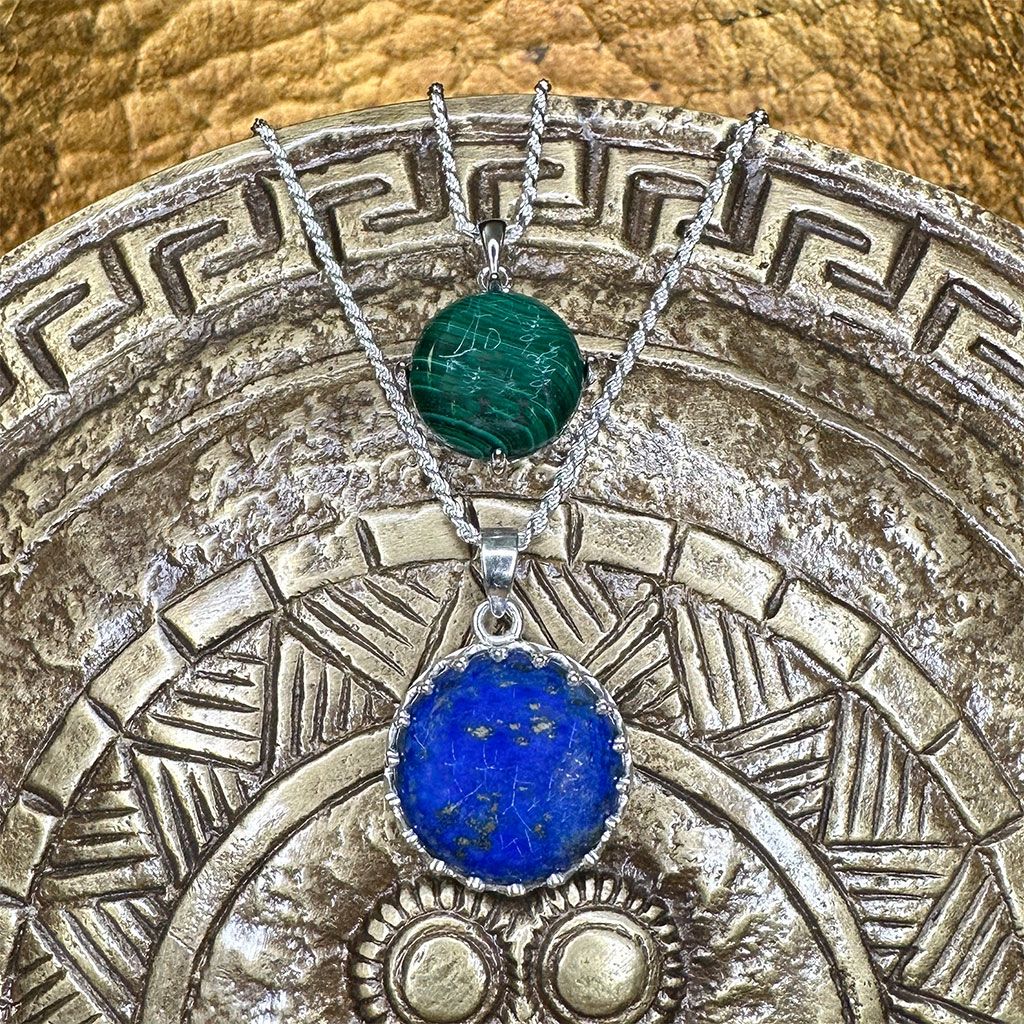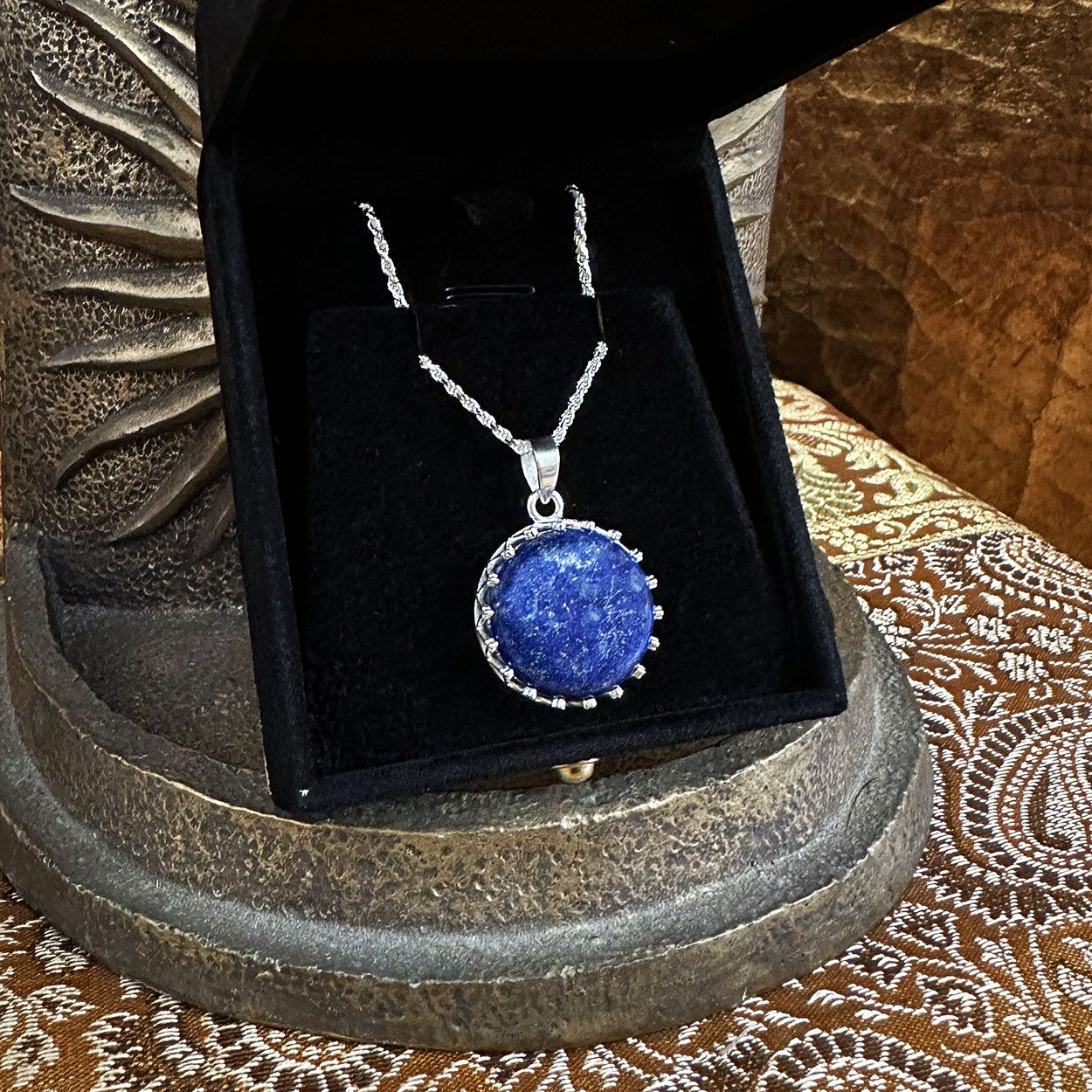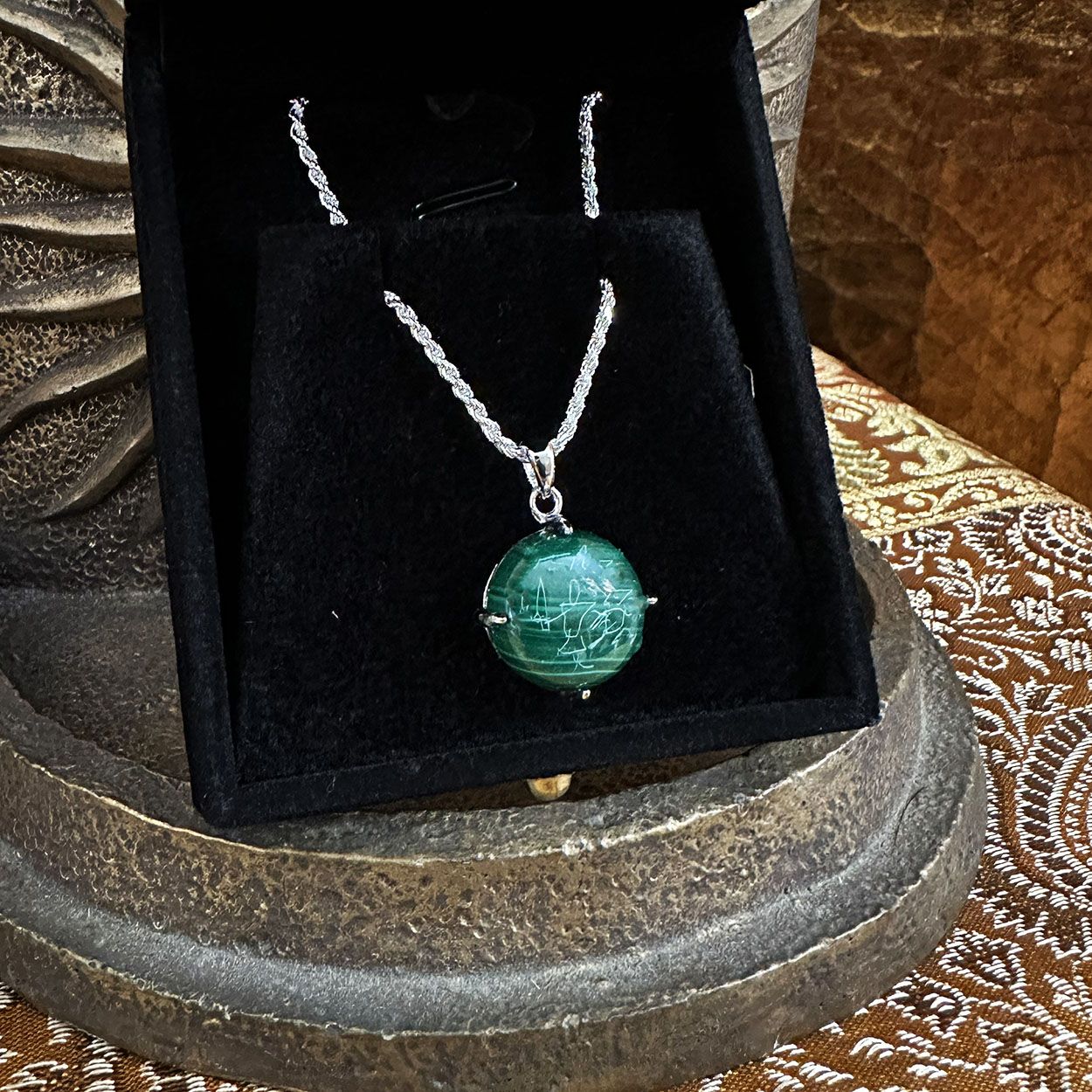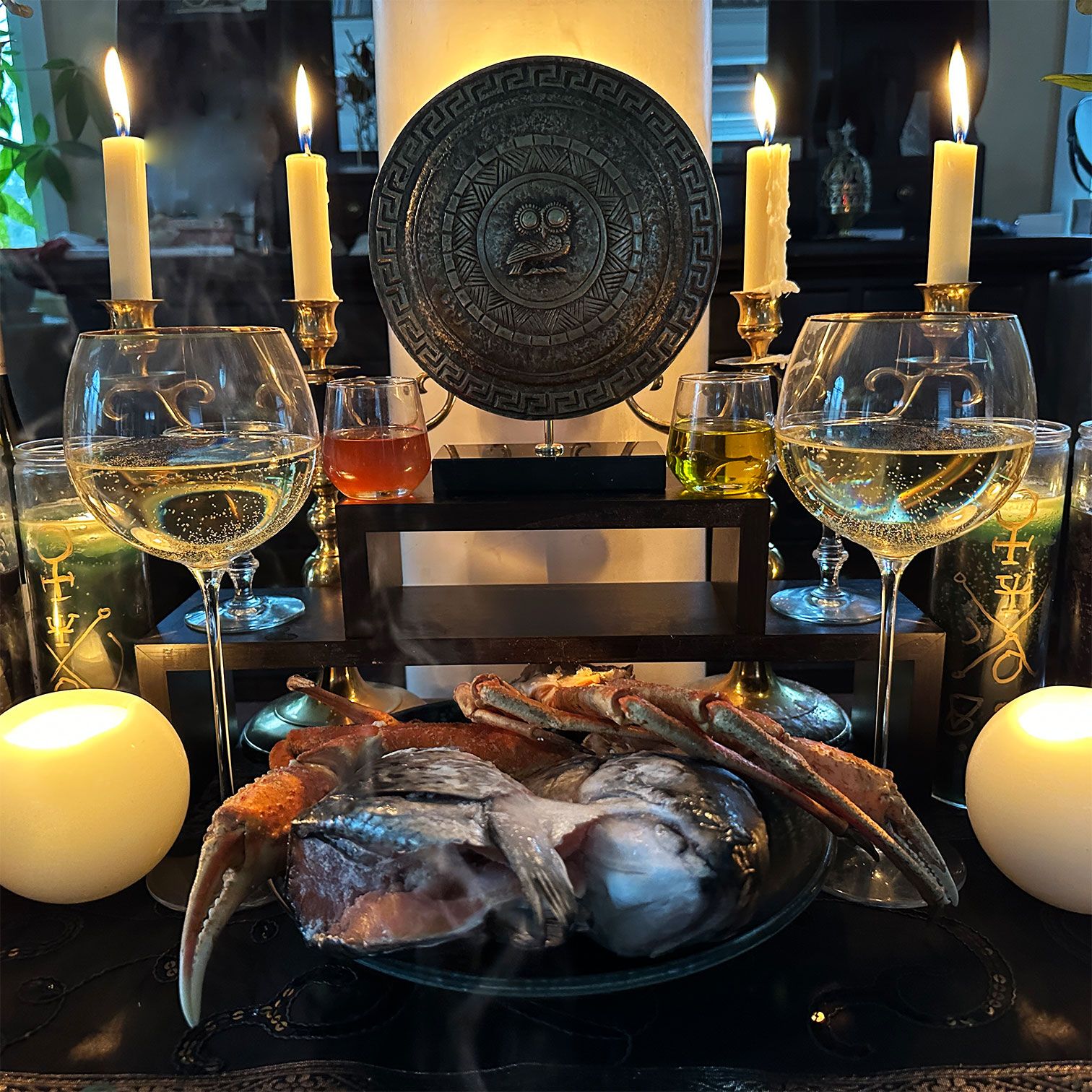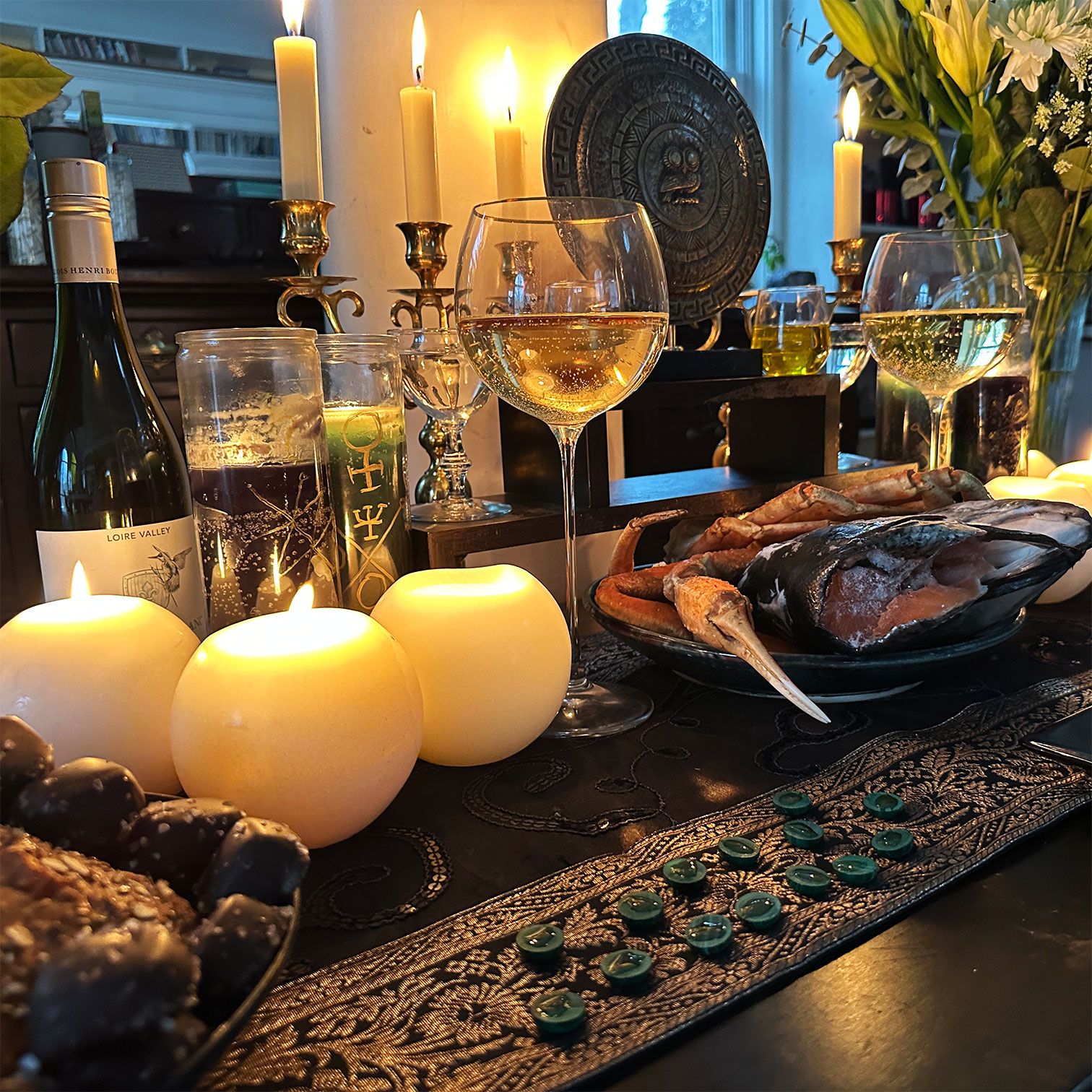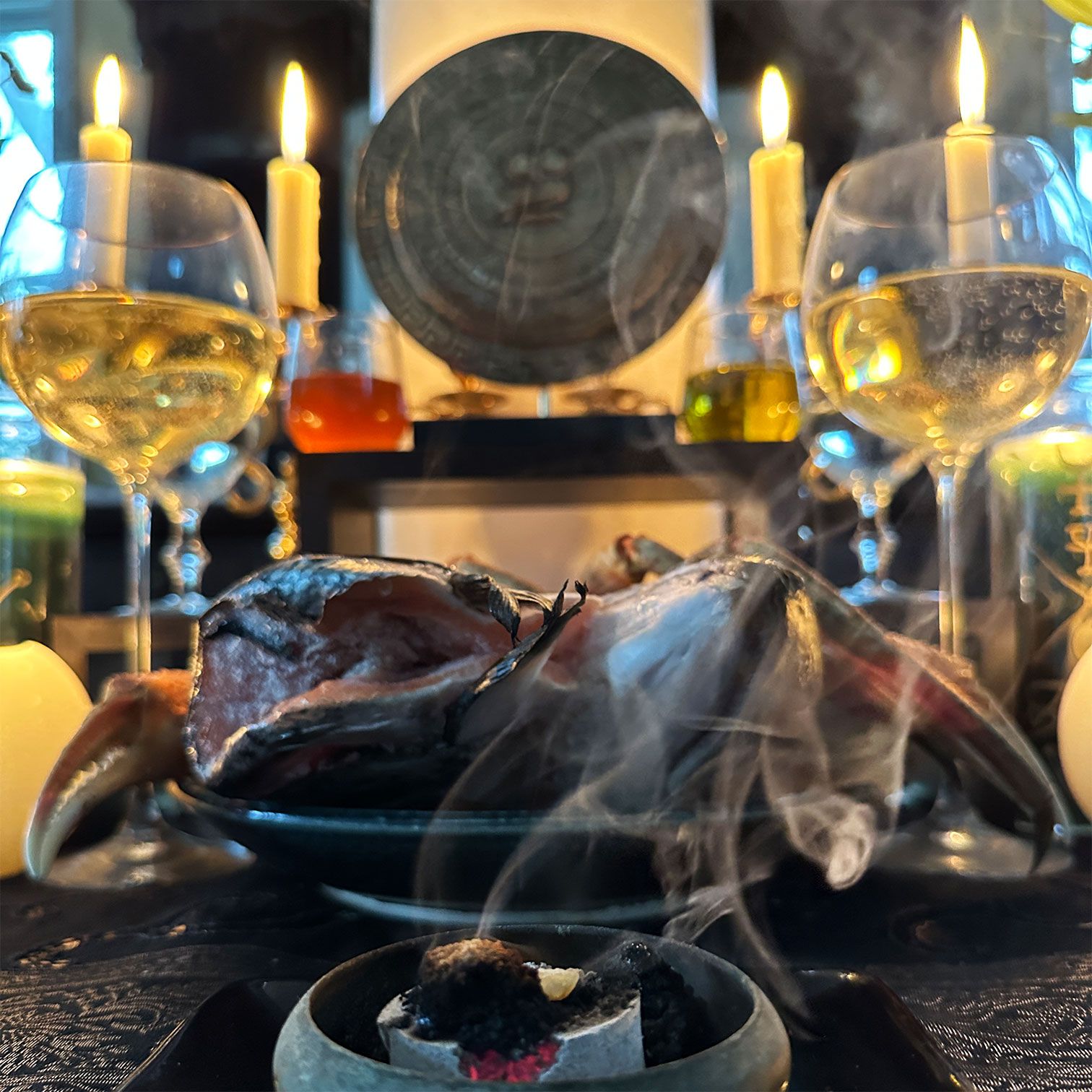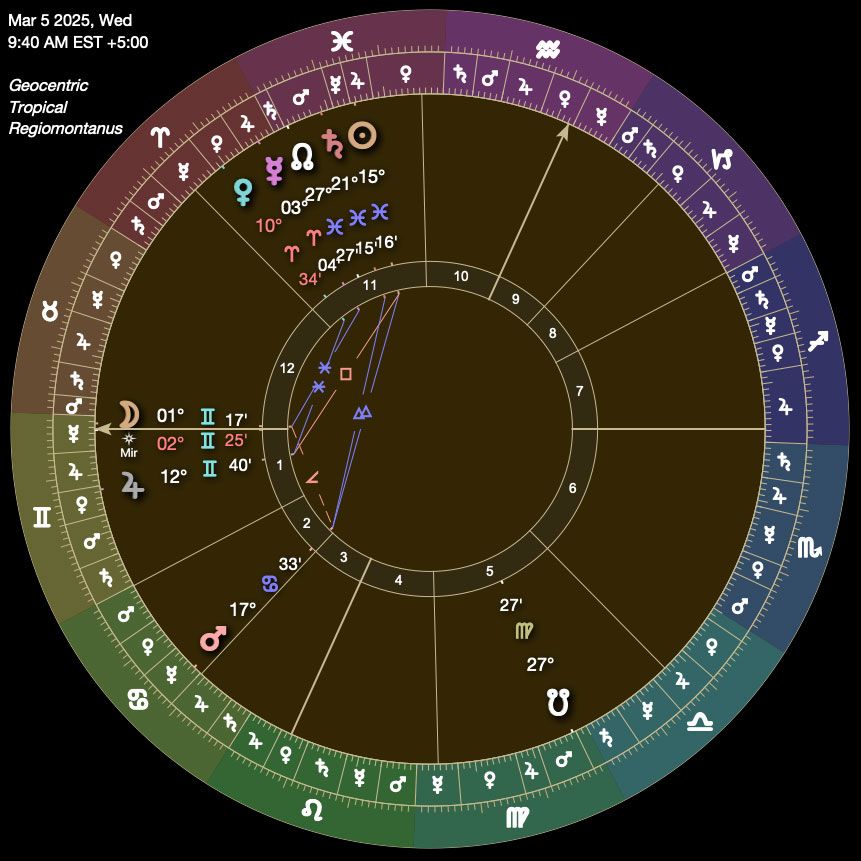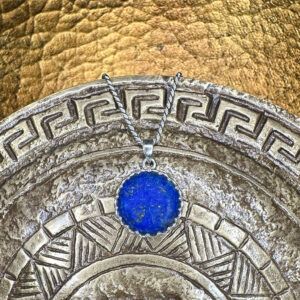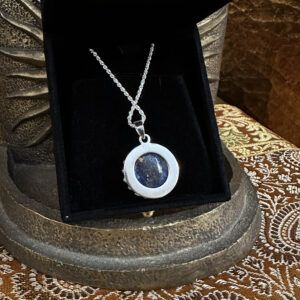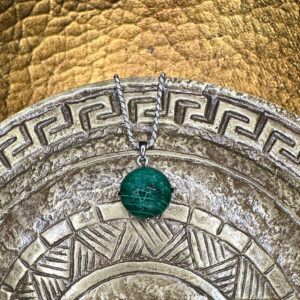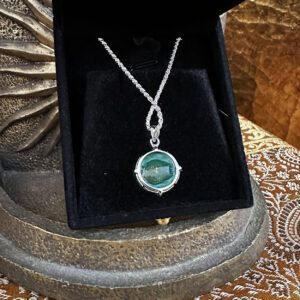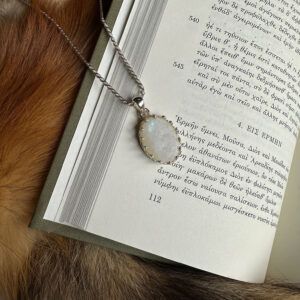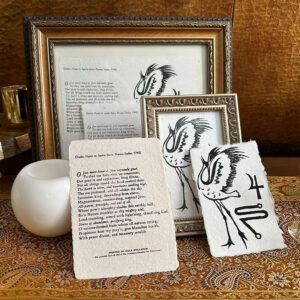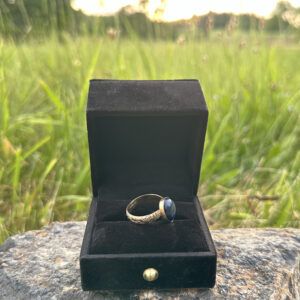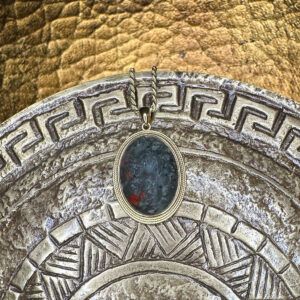Your cart is currently empty!
Perseus Constellation: Athena’s Shield – Lapis Lazuli & Malachite Pendant Talismans
$325.00
See “Description” tab below for full discussion of the Perseus constellation Athena’s Shield talismans.
Of the nature of the Perseus constellation, these talismans were created with the intent of granting the bearer protection, particularly from misfortunes, storms, witchcraft, and attacks by the envious.
Note: Since natural gemstones are endowed with significant variations, the talisman pictured is not necessarily the one you will receive should you elect to purchase one.
Ensouled on Wednesday, March 5, 2025 between 9:33am and 9:54am EST.
Description
Note: For an introduction to how we think about constellation talismans, we recommend checking out the following article: Constellations: The Mysteries of Relational Images.
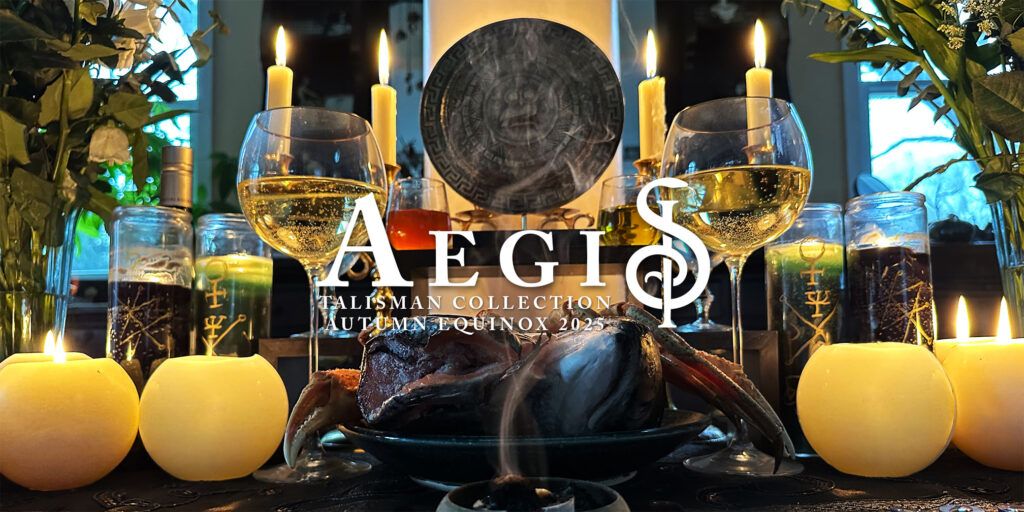
According to Albertus Magnus, Perseus talismans “protect from thunderbolts and storms, and from attacks by the envious” (Book of Minerals, tr. Dorothy Wyckoff, p. 145). Camillo Leonardi elaborates this somewhat, stating that such a talisman “protects its wearer from misfortunes and saves him from lightning and storms, it protects its owner and whatever place he happens to be against witchcraft” (Speculum Lapidum, tr. Margherita Fiorello, p. 32).
While protection from storms might have less relevance to most reading this thanks to modern convenience and Gore-tex, protection from “attacks by the envious” is perhaps more desirable than ever given the collision of ‘positivity bias’ of social media with ‘doomscrolling.’ Perseus talismans could therefore be seen as something like an astrological magic analogy to longstanding and widespread protective amulets such as the nazar, hamsa, Hand of Mary, and Hand of Fatima—all apotropaic (protective) magic to ward off the evil eye and misfortunes that come with it. Psychoanalytic theory casts envy as one of the most elemental and corrosively destructive forces of the personality: a hostile impulse that attacks life-giving aspects of reality, especially love and relatedness. No wonder that apotropaia aimed at averting envy is one of the most ancient and culturally widespread categories of magical artifacts.
Perseus, one of the largest constellations in the sky, is associated with the legendary hero of classical Greek and Mycenaean lore. We shall not recite the mythology of Perseus, which can be readily found online (for example at Constellation of Words and GreekMythology.com). Rather, we want to draw out two themes worth considering in light of the talismanic significations of the Perseus constellation.
First, the story of Perseus is not the story of a lone warrior whose prowess and virtues lead to victory. At virtually every turn, Perseus receives help—in particular, help from the gods. Without Hermes’s sandals and sword, Athena’s shield, and Hades’s cap of invisibility, Perseus’s heroic deeds would have surely been impossible.
Second, Perseus’s fame derives most prominently from his slaying of the gorgon Medusa, associated with the fixed star Algol. Warriors both patrol and transgress borders, and who gets cast as the hero depends a great deal on which side of the border you happen to be on. Whether you read the myth at face value or through a feminist lens, the Perseus constellation contains both hero and victim—Algol is, after all, a constituent part of the constellation.
After Perseus slays Medusa, he gives her head to Athena and she attaches it to the aegis—a word that means the shield of a deity, but also a violent storm or a goat skin (hence the goat skin featured in the Aegis collection banner image, beautifully prepared by Rose dè Danann of Silvertongue Studios). The same word refers both to a divine shield with tassels of pure gold lauded in the Iliad and to a simple, common goatskin. The triad between god, warrior, and monster creates a closed loop.
Indeed, the affixing of the gorgoneion to the aegis does not just link the monstrous and the apotropaic: it is almost the archetypal expression of it. According to the archaeologist and art historian Patricia A. Marx:
“The use of the gorgoneion for Athena’s shield blazon (and later as an addition to her aegis) implies that there is a need to ward off evil, for the gorgoneion is the apotropaic device par excellence. Not only was it hideous, it could turn one’s opponent to stone (Pindar, Pyth 10, 47-48), and the very thought that it might pursue him sent the intrepid hero Odysseus into a hasty retreat from Hades.”
—Patricia A. Marx, “The Introduction of the Gorgoneion to the Shield and Aegis of Athena and the Question of Endoios,” Revue Archéologique, 1993, p. 237
As ideas or archetypes, the warrior and the protector are in and of themselves ambivalent, even morally neutral. The nature of our own capacities as warriors or protectors, as well as our relationship to external warriors and protectors, depends upon how we understand our relationship to the monstrous—both without and within.
The Athena’s Shield talismans protect, but they also draw us into the questions and mysteries of protection, warriorship, and divine gifts. Who and what is it we are defending? What lengths are we willing to go to do so? From where do we draw our power? From the gods? From standing up to monstrousness? From coming into relation with our own monstrousness? How is relationship its own kind of training and preparation?
Practically speaking, the Athena’s Shield talismans draw us into a kind of active protection. We have noticed increases in physical activity and household emergency preparedness as themes that have come up from these talismans. Similar to Deneb Algedi talismans, which can increase contact with law enforcement and avatars of the legal system, these Perseus talismans can increase the presence of warriors and defenders in our lives. One of us noted that the adjustment period with these talismans was a little intense, contributing to a heightened and helpful alertness that did not tip into hypervigilance (even for Pallas who is prone to do so).
Finally, for some of us who live in storm-prone areas, or spend most of our time outside or on the road, protection from storms is a very relevant prospect. Late this summer, long after both Idola mages had introduced ourselves to our own Athena’s Shield talismans, we got alerts on our phones that there was a tornado warning for our county—quite rare, though not unprecedented in our part of the country where storms are common. On the radar, it looked like the storm was heading directly northeast toward us, and we took shelter as recommended (immediately donning our Athena’s Shield talismans). As the storm progressed, we got heavy rain but the storm system split as it approached us, with part heading north and part heading almost due east. Thousands were without power, but our lights flickered just a single time. In the aftermath, not only our property but our entire town was essentially unscathed by the storm system, with minor damage reported in towns north and south of us and a tornado actually forming about half the length of the state away to the east. Time will tell how this sort of effect will play out, but it was quite striking and worth sharing!
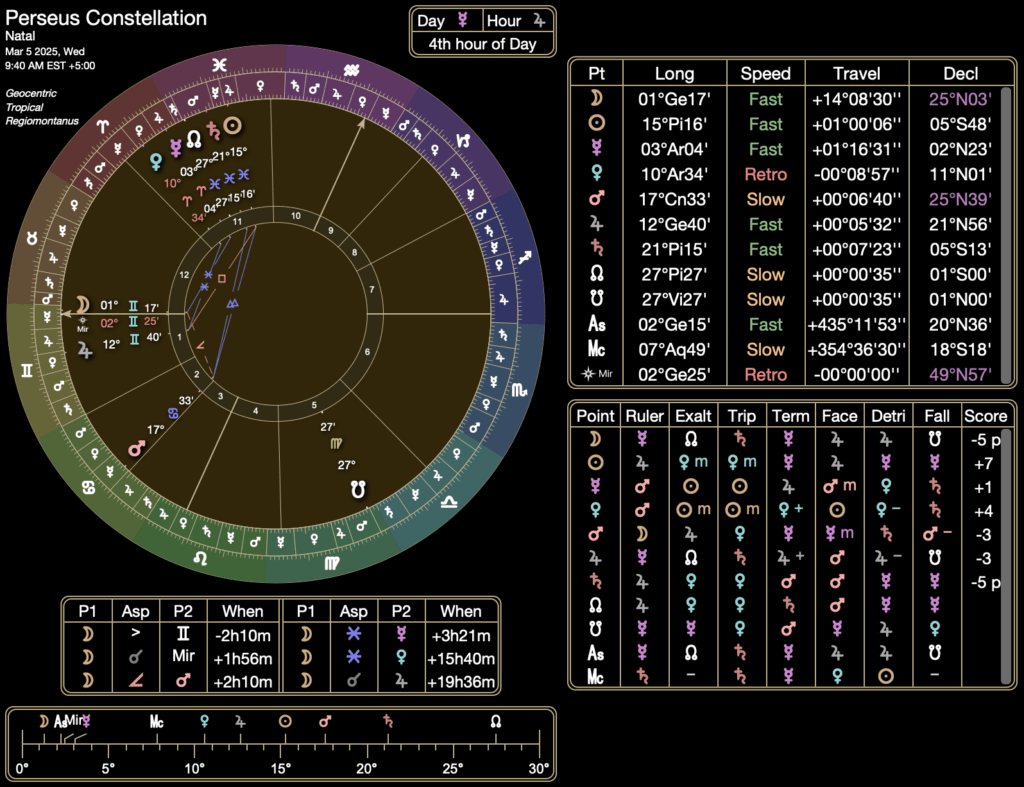
The Perseus Constellation Athena’s Shield talismans were ensouled on Wednesday, March 5, 2025 between 9:33am and 9:54am EST.
Essential Features of the Election
For constellational astrological talisman elections, we require that a prominent indicator star of the constellation either rises on the Ascendant or culminates on the Midheaven. In this election, Mirfak (at 2°25′ Gemini), the indicator star for Perseus that Christopher Warnock lists in his book Fixed Star, Sign & Constellation Magic, was rising on the Ascendant.
Constellation elections also require the Moon to be in sufficiently good condition and applying to the indicator star of the constellation. Idola Stellarum only works with lunar conjunctions (rather than other aspects, such as sextiles or trines) to fixed stars in talismanic elections. In this election, the Moon in the early degrees of Gemini was applying to conjoin Mirfak within just over 1 degree. Luna was waxing and moving with very fast speed, not applying to either malefic planet, and was applying by sextile to her ruler, Mercury in Aries.
Although we consider the condition of the Lord of the Ascendant to be a lesser factor in constellation elections due to their austere nature and remoteness from the sublunary realm, we always examine the Ascendant Lord for all elections since the first house represents the bearer of the talisman. In this election, the ruler of the Ascendant was Mercury in Aries. Mercury was peregrine and applying by conjunction to Venus, who, though in weakened condition as she is in detriment in Aries, still functions as a benefic in Picatrix-style electional context, imparting a slightly benefic cast to Mercury.
Note that for constellation talismans, planetary hour and/or day are not essential considerations.
Further Magical Factors in the Election
Although the Moon was not significantly afflicted in this election, we do note that the presence of Jupiter in the 1st house fortunates the election and mitigates potential issues with the Moon. Ficino writes:
“[L]ook for Jupiter or Venus either in the ascendant or in the tenth place, for so they compensate for the debilities of the Moon.”
—Marsilio Ficino, Three Books on Life, Book III, Ch. VI, p. 271 (tr. Kaske & Clark)
Reflection on Weaknesses of the Election
Though in fair condition, we do note that Mercury, the ruler of the Moon and the Ascendant, had their ruler Mars in fall in Cancer, and so was not in pristine condition. This is multiple levels down in the hierarchy of considerations however, and we mostly mention it for completeness, not out of concern. The condition of Mercury in magical elections primarily derives from the planets to which they are configured: in this case, the Moon in Gemini and Venus in Aries, giving Mercury a mildly positive valence as discussed above.
Recommendations
We do not issue any specific cautions about these talismans except to note that, as with any protective or health-focused talisman, Idola Stellarum cannot guarantee any specific protective outcomes related to our talismans, even in circumstances where health or protection is a primary aim of a magical working. Our talismans are not intended to diagnose nor treat any health condition or specific adverity, and anyone seeking medical advice or treatment should always consult with a licensed physician about any and all treatments.
Furthermore, we note that protection magic is less likely to be effective during active crisis. Apotropaic magic should always be only one of many layers of protection for one’s body, mind, and community.
Ceremonial Details
Gemstone & Talismanic Image
Gemstone associations with constellational talismans are not well attested. Our medieval sources for constellation talismans, such as Camillo Leonardi’s Speculum Lapidum and Albertus Magnus’s De Mineralibus, overwhelmingly list the effects of the image when engraved on “a stone” or “on gems” or the like. It is to be understood by the reader that the stone should be chosen according to lapidary lore and sympathy with the planetary nature of the constellations: under the constellation Andromeda, Magnus writes that the stone should be “engraved upon stones that are by nature conciliating in love” (tr. Dorothy Wyckoff, p. 142), pointing toward a general rule as to how stones should be selected.
In the case of Perseus, Leonardy reports that it “has the nature of Saturn and Venus,” indicating that stones of one or the other planet, and preferably both, should be selected for the working, and even more ideally, stones that have virtues geared toward protection and preservation. Out of several candidate stones, our divinations endorsed melochites (the medieval name for malachite) and saphirus (the ancient name given to the stone known in modern times as lapis lazuli—the name sapphire was not applied to blue and other colors of sapphire until much later in history).
Saphirus (i.e., lapis lazuli) was one of the most prized stones in the ancient world and was attested to have all manner of benefits. Albertus Magnus reports many medical benefits of the stone (p. 115). The entry in the Peterborough Lapidary for “Saphyr” clearly refers to lapis lazuli, and lists among the many benefits of this stone that it “destroy[s] foulness and envy, and comfort[s] the body and limbs” (tr. Francis Young, p. 64) and that it is also good for “break[ing] witchcraft” (p. 65), significations very much in line with those of the Perseus constellation.
Melocites (i.e., malachite) is said by Albertus Magnus to “have the power of protecting the wearer from harm, and [of guarding] the cradles of infants” (tr. Dorothy Wyckoff, p. 106). The Peterborough Lapidary likewise attests that malachite “keeps and saves children from harmful evils and mishaps; and whoever bears it… no wicked thing will grieve him” (tr. Francis Young, p. 82).
The image of Perseus, “an image [of the hero Perseus] having in his left hand a sword and in the right the head of Medusa” (Speculum Lapidum, tr. Margherita Fiorello, p. 32) was carved on the front of the stones with the name PERSEUS etched above. On the obverse, a blend of protective Saturnine and Venusian herbs chosen via divination, angelica root and birch bark, was affixed to the stone.
Ritual Setup

An altar of black and gold strewn with candles was erected to Perseus prior to the working, including candles on either side ritually consecrated to Saturn and Venus, the planetary correspondences of the Perseus Constellation according to Camillo Leonardi’s Speculum Lapidum. A bronze statue of a decorative shield emblazoned with the owl of Athena served as the centerpiece of the altar, with offerings of the claws and heads of sea creatures below to symbolically capture Perseus’s defeat of Cetus. Offerings of food, wine, spirits, honey, olive oil, and fresh flowers also adorned the altar.
Suffumigation
Suffumigation and incense offerings consisted of high quality Yemeni myrrh mixed with the herbs chosen by divination: angelica root and birch bark.
Additional information
| Weight | 1 lbs |
|---|---|
| Dimensions | 14 × 11 × 2 in |
| Type of Talisman | Constellation |
| Date of Election | March 5, 2025 |
| Electional Window | 9:33-9:54am EST |
| Talismanic Image | The image of the Perseus Constellation from Albertus Magnus's Book of Minerals: “Perseus, holding in his right hand a sword and in his left the Gorgon’s head” |
| Suffumigation | Yemeni myrrh, angelica root, & birch bark |
| Herb(s) | Birch Bark & Angelica Root |
| Gemstone | Lapis Lazuli, Malachite |
| Gemstone Origin | Unknown |
| Jewelry Type | Pendant |
| Jewelry Setting | Sterling silver |
| Chain Type | Sterling silver |
| Perseus Talisman | Lapis Lazuli (20mm), Malachite (16mm) |

